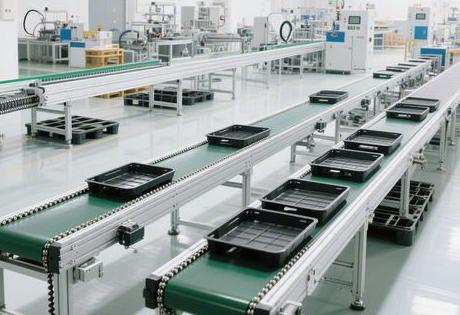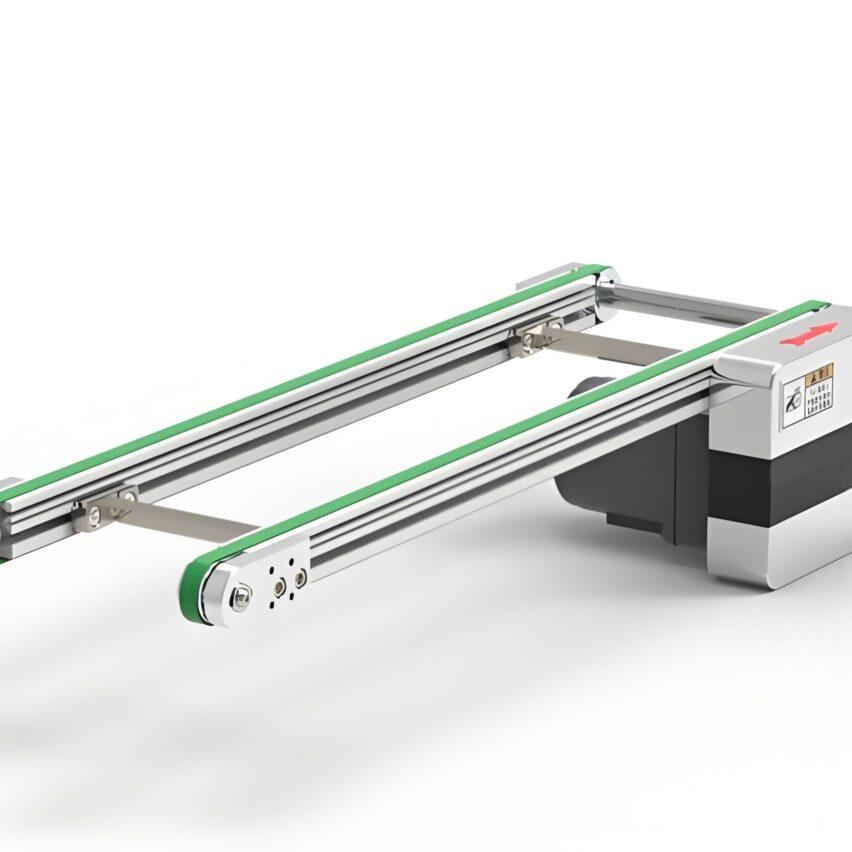### The logic of innovation: how vertical loops reconfigure the production space
The biggest pain points of the traditional assembly line areUnloaded tooling plate occupies more than 30% of horizontal spaceThis forces operators to juggle assembly and material flow in a limited area. The double-deck speed doubler chain is designed to do this through the use ofThree-dimensional separation structure of "upward and downward" productionIn addition, the empty panel return is moved to the lower level, directly freeing up the effective working area of the upper production area. In the case of an automotive seat assembly line, for example, the design saves 40% of floor space while maintaining a high beat rate of 60JPH (60 pieces per hour).

I think the essence of it isCracking the flat layout impasse with vertical dimensions-When the workpiece board completes the assembly task, it is vertically lowered into the lower aisle through the transfer machine and automatically returned to the line at the same speed. This physical layer reconfiguration not only compresses the length of the production line by 40%, but also eliminates the time loss of operators waiting for empty boards, and improves the utilisation rate of the workstations by more than 25%. Especially for the complex process, the number of workpiece boards more than 100 continuous production scenarios (such as mobile phone motherboard mounting line), this cycle logic directly hit the core of the contradiction between efficiency and space.
Core structure and speed-up principle: a subtle synergy of mechanical design
Hierarchical system design
- upper chain of production: Adopting 2.5x or 3x speed chain, the actual speed of the work plate reaches 2-3 times of the chain speed (up to 20m/min). Aluminium profile guide rail with anodic oxidation treatment, straightness error ≤1mm/m, ensuring the positioning needs of precision assembly.
- Lower Return Channel: The unloaded pallets are returned to the line via a separate chain or belt system, consuming only 30% of the upper level.
- Shifter hubsIt consists of jacking cylinder (output force is selected according to the load) + power module (chain/belt drive), with a load capacity of up to 500kg and a jacking height error control of ±0.5mm.
Speed doubling mechanism
hinge onDifference in diameter between roller (diameter D) and roller (diameter d)::
- Velocity formula: Vtooling board
= Vsprockets
× (1 + D/d) - When D = 2d: Workpiece plate speed up to 3 times chain speed (e.g. chain speed 0.7m/s, workpiece speed 2.1m/s)
- physical principle: Roller and guide rail friction driven rotation, superimposed on the chain forward speed, the formation of composite motion.
Compared to traditional conveyor lines, this designAvoid high speed chain shake, while enabling controlled acceleration through the physical structure.
Industry Adaptation and Scenario Evolution: From Electronics Assembly to New Energy Production Lines
Precision Revolution in Electronics Manufacturing
- Light load high-speed scenariosEngineering plastic roller chain (load <30kg), with ±0.1mm servo positioning, suitable for PCB mounting.
- Value of Jaeger's function: 4-station cache area on the lower level to maintain 80% capacity in case of single point of failure (e.g. temporary storage of defective products in mobile phone test line)
Just-in-time breakthroughs in automotive heavy-duty
- Engine assembly line: carbon steel chain plate + bearing rollers, single point load 1000kg
- Tesla Shanghai Factory Case: RFID Chip Dynamically Adjusts Beats, Increasing Efficiency by 22%
Hygienic upgrading of medicinal foodstuffs
- All stainless steel chain + dirt-free guides, reduced cleaning time 40%
- GMP compliant design: food grade lubricant, anti-bacterial coating
Extreme Challenges in New Energy
- LONGi Green Energy PV workshop: high temperature resistant chain (-20℃~120℃), debris rate reduced to 0.05% in dust-free environment
Technology Inflection Point: The Converging Leap of Modularity and Intelligence
Modular racks form a competitive barrier
- Guideway T-slot designSensor retrofitting time <1 hour, station adjustment cycle time compressed to 4 hours (3 days traditionally).
- Drive segment control: Individual inverter motors for every 20 metres, reducing energy consumption by 15%
Predictive Maintenance Reinvents Stability
- Real-time monitoring of chain elongation, automatic warning of wear exceeding 2%.
- An enterprise measured data: failure rate down 50%, maintenance cost savings 20%
Millimetre war for positioning accuracy
- Magnetic encoder + RFID double calibration, error ≤ 0.5mm
- Improved assembly yield by 6% compared to conventional cylinder blockers (±2mm).
Precise balance of costs and benefits
| Assessment dimensions | Key indicators | Industry benchmark values |
|---|---|---|
| Space costs | Floor space saving ratio | >30% |
| load efficiency | Factor of safety (load/limit) | ≥1.5 |
| payback | Payback cycle for equipment upgrades | 14 months (IIoT systems) |
SME Adaptation Programme
- Light load scenario: 2.5x speed engineering plastic chain, lower cost than 3x speed carbon steel chain 40%
- Heavy load scenario: 2.5x speed carbon steel chain + increased drive points, speed compensation up to 3x speed effect
Exclusive data insights: Industry forecasts to 2025 show the adoption ofModular Double Layer Multiplier Chain + IIoTThe OEE (Overall Equipment Efficiency) of the factory can reach 92%, which is 17 percentage points higher than the traditional production line. The landing of the magnetic levitation drive solution will make the power consumption of a single metre drop another 40%, completely rewriting the rules of energy efficiency.
Self-questioning on core issues
Q: How do I deploy a two-tier system in a shop with insufficient space height?
A: Three major compression solutions to crack the floor height limit:
- Thin Transfer Machine: Patented design compresses the total height to 1.8 metres (e.g. Yuansheng Intelligent Solution)
- Lower belt return: Thinner than chain structure 30%, suitable for low profile plants
- localised bilayer: Only critical work stations are double-layered, the rest remain single-layered.
Q: Why do high-end electronics manufacturers favour 3x speeds over 2.5x speeds?
A. At the coreTime window for precision assembly::

- The 3x speed chain enables the workpiece to move at speeds of up to 20 metres per minute, which is 17% faster than the 2.5x speed.
- Mounter and other equipment beat ≤ 1.5 seconds, the speed difference directly affects the balance rate of the production line
- For every 0.1x speed increase, the average daily production capacity of the production line increases by 1,200 pieces (taking the mobile phone line as an example)













